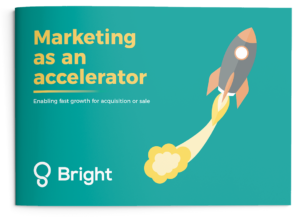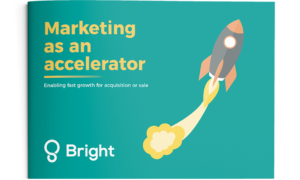Marketing may not be the first thing that comes to mind when looking at selling your business, or at buying one, but it should sit firmly alongside commercial and financial due diligence. In the same way that a marketing strategy is key to any business looking for rapid growth, it is also a good benchmark of the business’ strength and its potential to deliver a return on investment.
A good marketing strategy will underpin and complement the key elements that business investors look for: strong financials, potential to grow and a competitive position in the marketplace. Mike Altendorf, a London-based advisor and investor, observes that “marketing plays a big role in the value of a business. Buyers will often look for businesses that have an effective and proven marketing strategy and delivery – but it’s also key to attracting the attention of the buyer in the first place.”
So, what are the top five reasons why marketing is key to your exit strategy?
For further insight into why agile marketing is a critical driver for growth , download our eBook: “Marketing as an Accelerator”
1. A strong sales pipeline
Marketing is key to every aspect of a strong sales pipeline. It plays a big part in generating leads, securing repeat sales and turning prospects into new clients.
Organic growth can only take you so far, so a strong pipeline – created by strategic agile marketing – is a key element of fast growth. It indicates the ability to adapt and capitalise on market change, resulting in a higher potential profit, a better return on investment and therefore a better valuation – making the difference between a mediocre sell price and an excellent one
2. Sharp, consistent messaging
A sharp, consistent message comes from a strong value proposition and expert marketing. Being able to wear your brand on your sleeve means potential buyers know exactly what your business stands for and what you’re selling, giving a good idea of what they are investing in. Marketing ensures that the value proposition is front-of-mind and never wavers; it cuts across everything that potential customers, buyers or investors, see, hear or feel from the company.
3. A clear brand and effective website
Brands sell. They sell products and they sell businesses; they generate superior leads and attract high-quality investors. And websites are often the first point of contact with a brand. When done well, they are an opportunity to showcase the best that the company has to offer and an asset to the sales pipeline. But when done badly, they are detrimental to fast growth. Investors are unlikely to consider a company if little effort has been put into its brand, of which a good website is a key element. It’s important to make that great first impression – then carry it through to closing.
4. High brand awareness
As important as a brand is, it is absolutely worthless if no one knows about it. And this is where marketing comes into its own. A great marketing strategy is essential to high brand awareness and the best strategy combines creative ideas, partnerships, great content and leveraging customer referrals. Data-driven metrics are also essential as they provide a constant review of the marketing components in play.
If the above factors are implemented, the application of the strategy should, in theory, catch the attention of potential customers, but it’s the metrics that will catch the buyer’s or investor’s eye. You can’t argue with the hard numbers, and if they show a growing, profitable business and a busy pipeline of new clients, it puts the seller in strong stead with those wishing to buy.
Learn more about branding for Mergers and Acquisitions in this article.
5. Capitalising on the potential of social media
Out of the 3.5 billion internet users around the world, 3.03 billion are active on social media, giving businesses two important opportunities:
- the chance to build a greater brand awareness on platforms specifically aimed at target groups, and
- the potential to give customers, prospects or investors a deeper, more personal connection with the brand.
The reason it works so well is because companies can show personality, and interact with potential customers, clients and industry leaders on a one-to-one, more personalised level. It builds brand awareness through thought-leadership and content-sharing, as well as building an emotional connection with competitions, giveaways or referrals. A strong marketing strategy will ensure that it’s a tool that leads to potentially lucrative relationships and sales
Marketing maximises the value of your business
A strong marketing strategy is one of the core elements of any exit strategy. Combined with its ability to enable high growth, it is something all leaders should be encouraged to implement at the beginning of their business journey for the five reasons featured above.
This can be achieved by partnering with expert marketers in-house or bringing in outside consultants. Either way, aligning your sales and marketing, and establishing a clear brand are essential to the longevity and profitability and, ultimately, saleability of your business.
Read more about how marketing is key to high growth and exit strategies in Bright’s new eBook: “Marketing as an Accelerator” – including commentary from business leaders and investors.






